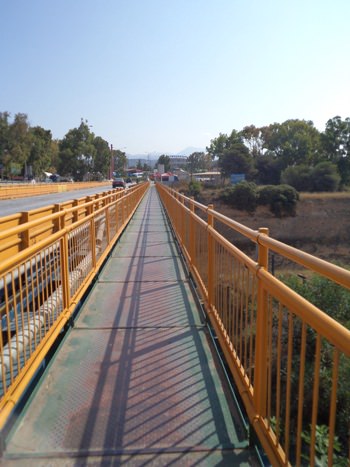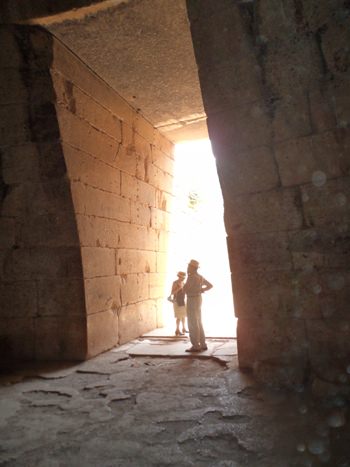I hadn’t expected to visit the Canal of Corinth, Agamemnon’s tomb and Epidaurus on this trip, but Athens was a nightmare. I had arrived in the middle of violent demonstrations against the government’s austerity measures. Roads were closed off which made getting from A to B extremely difficult, even on foot, unless you wanted to risk life and limb. The Acropolis was shrouded in scaffolding and plastic sheeting with huge cranes towering over it. Many museums were closed. A situation which finished off my original Athens sightseeing plans.
Thankfully, I was ensconced in a very luxurious hotel, contemplating my options from my roof terrace. A seasoned traveler always finds a way to make the best of any given situation. To my delight, I found a brochure at reception offering several guided tours away from the capital. Although I don’t normally fancy guided tours, this seemed a good opportunity to visit sites I hadn’t been to before without the hassle of going around road blocks and other obstacles in a hired car.
What caught my eye was a day trip which started with the Canal of Corinth. I always had a romantic notion of this man made canal where big ships have to squeeze through, nearly touching the sides, not to mention the bottom.
Key Tours collects you from and returns you to your hotel. After the Canal of Corinth, they proceed to Nafplia, Mycenae and the world famous antique theatre of Epidaurus. Ideal. The cost is EUROS 89 per adult plus EUROS 10 for a set lunch if you want.
Canal of Corinth
After a very pleasant drive along the coast, our excellent tour guide who doubles as a history student, which helped a lot, announced: “We are now approaching the Canal of Corinth where we will have a short stop. You will have the opportunity to walk over the bridge and get a look at the canal.” It was fortunate she alerted us, because: blink an eye and you would have missed it!! For some reason I imagined a massive structure, something along the lines of the Panama Canal. But instead, we crossed a very narrow bridge and were on the other side of the canal in a matter of seconds. The canal separates the Peloponnesian peninsula from mainland Greece and saves ship traffic the long haul around the Peloponnesian peninsula. The original plan to dig a canal goes back to ancient times. Tyrant Periander planned it in the 7th century BC, but abandoned the idea due to heavy construction costs. Instead, he built a tow path across which ships could be pulled, and he levied a hefty fee for the service which filled his coffers nicely. From the Romans to Ottomans to modern times, the idea of the canal was revived and overturned. One of the reasons was, again, the forbidding costs and another – geological problems. The ground was prone to landslides making it difficult to maintain a canal. Finally, the canal was inaugurated in 1893, but it wasn’t a great success. Modern ships soon grew far too big for the 70 ft. wide waterway, landslides did occur and it needed constant repair and dredging.
Today, the canal is mostly a tourist attraction with boat tours at sunset. Walking over the bridge and looking down into the depths of the canal makes you appreciate the magnitude of this engineering feat. the construction was. The rock walls bordering the canal are nearly vertical with the odd tree making a brave attempt at growing out of the solid rock.
Mycenae and Agamemnon’s Tomb
Back in the coach our next, far too brief stop, was Nafplia, the first capital of Greece. It is a delightful seaside town with an imposing Ottoman castle towering over it. On a future visit I will certainly spend a day or two in Nafplia alone. But, our primary destination today was the mythical Mycenae, home of King Agamemnon. From 1600 BC to 1100 BC, Mycenae was a major center of Greek civilization. What makes the place so attractive and interesting are the myths and legends as told by Homer. These legends largly involve King Agamemnon, his wife Clytemnestra, and the sacrifice of their daughter, Iphigenia. This was all done to appease the gods and let the winds blow so their ships could sail to Troy to embark on the 10 year war to get Helena back. Heinrich Schliemann, the very wealthy German business man and hobby archaeologist had a dream: inspired by Homer he wanted to find Troy and Mycenae and he succeeded in both enterprises.
The historical site of Mycenae is huge, dominated by the citadel and the much visited and photographed Lion Gate, the significance of which is still unclear. Further outside the walls of the citadel are the tombs of the kings, massive, conic structures one of which is supposed to be the tomb of Agamemnon. The tombs are empty, but Schliemann, when excavating the site, discovered a gold treasure, among which includes ‘The Mask of Agamemnon’. Next to the site is a museum with exhibits of replicas of the treasures found here. A piece of advice: don’t visit in summer. It gets very hot and there is no shade.
Epidaurus
The final destination of our tour was the theatre of Epidaurus, renowned for its excellent acoustics. Whereas the site of Mycenae is quite barren, the surroundings of Epidaurus are full of olive trees, woods, plants and…birds. The theatre is only a part of a complex which, in antiquity, was the most important and celebrated healing center of the classical world. The birthplace of the god Asclepius, people came to this sanctuary in search of a cure for their ailments. They had to spend the first night in communal sleeping halls and in their dream, the god himself would appear and tell them which cure was appropriate for them. Parts of the sleeping halls have been discovered as well as thermal baths, a gymnasium and many other amenities. All these people wanted entertainment too and that’s what they found in the theatre. It’s well preserved and when I climbed up and reached the top tier of the bleachers, I got a lovely surprise. Another visitor stood in the middle of the theatre and started to sing opera. I could appreciate with my own ears how fabulous the acoustics are.
At the end of this truly fabulous tour I was even reconciled to the uproar back in Athens.
Written by Inka Piesga-Quischotte for EuropeUpClose.com





Inka
Sunday 5th of August 2012
Thanks for asking maq203. I was staying at the Royal Olympic Hotel. Very nice, fantastic views to Lykabetos Hill on one side and the Acropolis to the other. Expensive though.
rehan
Thursday 2nd of August 2012
Awesome the canal look very cool, adding this in my list to visit before i die lol
maq203
Wednesday 1st of August 2012
Wow, the canal and tomb look amazing! Looks like everything works out for a reason. What hotel did you stay in in Athens?
Christopher Franko
Wednesday 1st of August 2012
I can only imagine whats going on in Athens. This however seems like a great adventure tho.